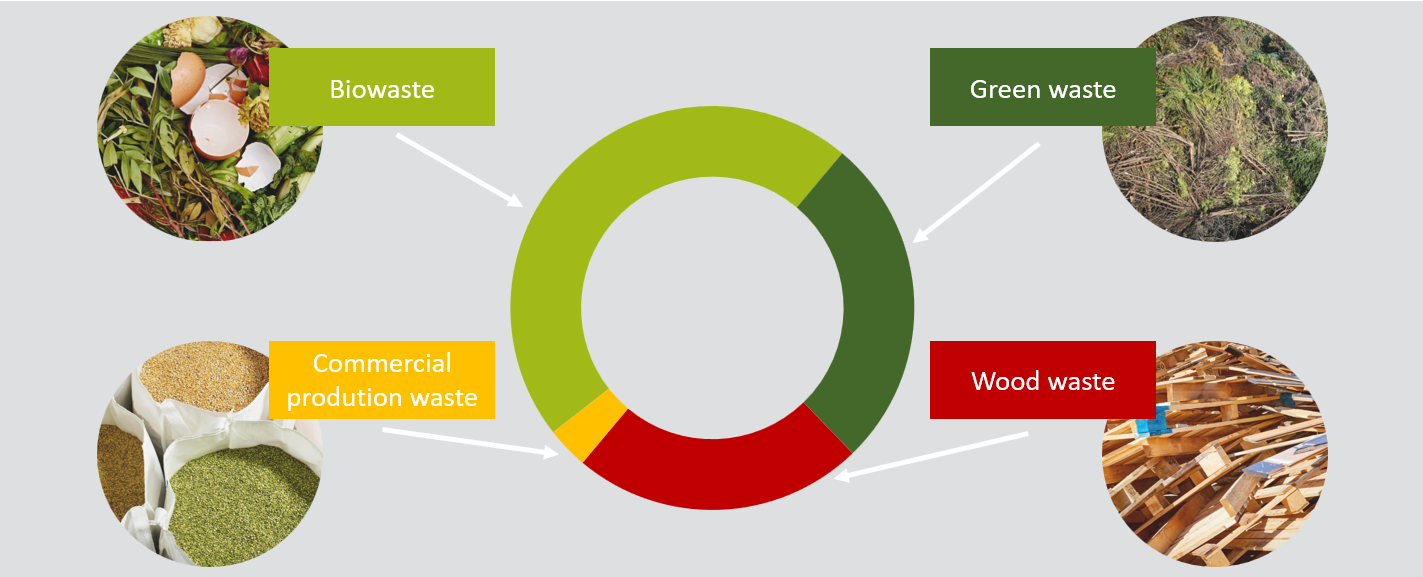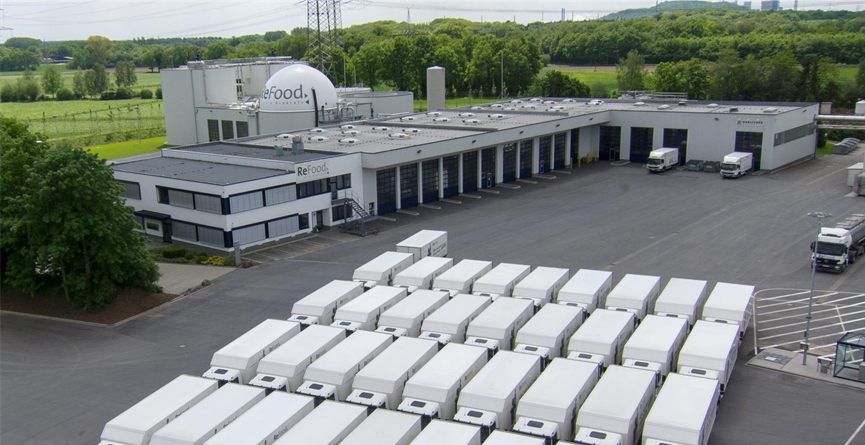Search
The REMONDIS Group’s locations
Discover the world of REMONDIS with its approx. 900 branches and associated companies in over 30 countries across Europe, Africa, Asia and Australia.
Co-existing with Biogas
Can you guess what connects carbon footprint reduction, clean energy production, and agriculture at the same time? The answer is a biogas plant which looks like a tank with a round roof!

What is a biogas plant?
What is a biogas plant? First of all, we would like to introduce you how a biogas plant system works.
A biogas plant system includes four parts: input collection, anaerobic fermentation, biogas utilization, and fertilizer utilization.

1. Input collection
The input for biogas plants is biowaste, which can include manure, food waste (including kitchen waste), animal and plant by-products, and organic sludge. These biowastes will be collected and transported to the biogas plant through a private or governmental waste collection system.
2. Anaerobic fermentation
After entering the biogas plant, the biomass waste will go through a pre-treatment, such as a biofilter to eliminate odor. Afterwards, the pre-treated biowaste will be pumped into a fermenter, in which the biowaste is converted into biogas and digestate under anaerobic conditions controlled by natural microorganisms.
3. Biogas utilization
The biogas is a high-quality and low-carbon fuel which is rich in methane (CH4). After a desulfurization and purification process, biogas enters the CHP (co-generation of heat and power) generator to generate renewable energy which includes electricity and heat.
4. Fertilizer utilization
The digestate is a high-quality fertilizer rich in humus and plant nutrients, which can be directly applied to agricultural land in the form of liquid fertilizer. This close thecycle of nutrients and carbon and reduces the use of chemical fertilizers.
The biogas plant system is a total solution to practicing a circular economy. This is prevalent in European countries such as Germany and the United Kingdom.
Take Germany, where biogas production has been developed for more than 20 years, for example:The number of biogas plants is more than 9,300, and bioenergy accounts for 9.4% of the total energy consumption.
This is enough to supply electricity to 9.52 million households, which is the equivalent of 3-4 nuclear power plants.
The biogas plant is a total solution!
In fact, biogas plants are not only a waste treatment method, but also a comprehensive solution for the public sector, agricultural sector, industrial sector, etc.
The anaerobic fermentation process in biogas plants is a natural microbiological activity. In order to ensure the fermentation works smoothly, pasteurization as a pre-treatment is installed. This sanitization pre-treatment process is a very effective method of controlling animal epidemics such as African Swine Fever (ASF) and foot-and-mouth disease. Take Germany’s risk-based biowaste management framework for example, all the general biowaste (e.g. household kitchen waste, manure, sewage sludge, green waste, etc.) are designated to biogas / composting treatment, and only commercial animal by-products (like clean single-source food waste) are diverted to feed, biogas / composting, and landfill treatment in accordance with the risk category.

If we could follow the German biowaste management framework, which only allows low risk commercial animal by-products to go to feed production and requires all of the non-homogeneous and unpredictable general biowaste (e.g., household kitchen waste) to go into the biogas plant treatment system.Through that, the spread of epidemics due to food waste fed to pigs can effectively be prevented.
Contact us to find out more about the Germany biowaste management framework
Biogas plants are also an important carbon reduction solution for a country with a Net Zero target. This is because biogas can be converted to low-carbon renewable energy, and digestate can be used as high-quality fertilizer to capture organic carbon in the soil.
The renewable energy generated from biogas includes both stable electricity and heat. The stable electricity can compensate for the fluctuation of intermittent renewable energy such as solar and wind power. On the other hand, the thermal energy can be used as process heat, or even be utilized to provide heat to peripheral facilities. For instance, rapid fermentation, feed conversion, or warm water swimming pools generally consumes lots of electricity for heating, and substituting electricity with CHP heat can not only save energy but also reduce its carbon footprint. These are all important aspects of energy transformation and the Net Zero target.
If we could follow the Germany biowaste framework, which allows biowaste from different sources, such as households, businesses, and agriculture, to be treated together in biogas plants, we can contribute to accelerating Taiwan's energy transformation and reaching the Net Zero target!

Is co-digestion feasible / safe?
Since the current regulations of biowaste in Taiwan are mainly classified according to the different authorities related to the sources (e.g., household food waste - Environmental Protection Administration, commercial animal residue - Ministry of Economic Affairs, livestock manure - Council of Agriculture), each authority may have doubts about the technical feasibility and environmental safety of the co-digestion of biowastes from different sources.

With more than 20 years of experience in operating biogas plants, the REMONDIS Group has more than 70 biogas plants in operation around the world. Each of the biogas plants may treat different feedstocks. The combination could be livestock manure and household food waste, household food waste and business animal waste, or food waste and agricultural straw waste. Therefore, we can showcase the technical feasibility of co-digestion with our long term and steady track record of biogas plant co-digestion operation. Just visit our Market Development to find our biogas plant demonstration video.
On the other hand, Germany’s biogas plant related framework is very comprehensive. This includes regulations and third-party verification. The regulated aspects incorporate the sterilization pre-treatment, the hazardous sulfides and flammability safety control, and the standards of digestate fertilizer.

Development of Biogas co-digestion in Taiwan
Finally, let's look at the development and potential of the biogas industry in Taiwan.
The Taiwan government has been developing policies related to the biogas industry since 2013. This includes the Environmental Protection Administration's (EPA) Livestock Organic Waste Recycling Promotion Program, the Bureau of Energy’s (BoE) Biogas Power System Subsidy and Renewable Energy Barging Rate, and the EPA's regulations on the utilization of manure digestate and food waste digestate on agricultural land.
According to Circular Taiwan Foundation, Taiwan has the potential for 150 centralized biogas plants and an annual organic resource of 20 million tons. Whether it is a manure biogas plant, a household kitchen waste bioenergy plant, or a manure and commercial food waste co-digestion biogas plant, Taiwan's biogas industrialization is ready to take off as long as the proper structure is under proper development.

The above may be difficult to understand at first. After all, the co-digestion of biogas plants in Taiwan is still in the early stages of development. But don't worry! Just contact us. and we will be more than happy to answer your questions!
Sources
(1) Anzahl der Biogasanlagen in Deutschland in den Jahren 1992 bis 2021
(2) EPA Subsidy for Local Governmental Promotion of Livestock Manure Nitrous-N Collection and Treatment Demonstration Program
(3) BoE Biogas Power System Subsidy
(4) The 2022 Feed-In Tariff of Renewable Energy
(5) Biogas Generation Promotion Site: Digestate application
(6) Circular Taiwan Network《Cycle Taiwan 2040 New Opportunity for Taiwan's Biogas Industry》



